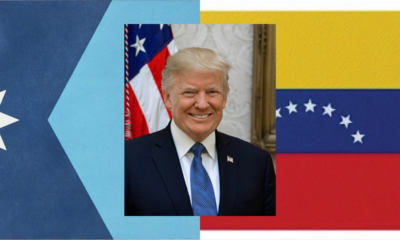Guest Columns
Welcome to the Influencer Era of Politics
Political campaigns can serve themselves better by cultivating an influencer than by placing a big cable TV ad ever fewer people watch.

Political campaigns can serve themselves better by cultivating an influencer than by placing a big cable TV ad ever fewer people watch.
We live in an era in which cable television news is set to go the way of the 8-track tape player, and the changing media landscape is profoundly impacting how Americans get their political news.
The influencer challenges the cable network
As CNN, Fox, and MSNBC’s audiences shrink and age, the influencer era in American politics is officially underway.
If you need any convincing, zoom in on the Republican and Democratic conventions that wrapped up a few weeks ago. According to a recent RealClearPolitics article, around 200 content creators (or influencers) received credentialed invitations to the Democratic National Convention. This included exclusive access to VIP parties and events, as well as the chance to meet some of the delegates involved in the selection process.
Based on your age, it’s relatively easy to predict how you consume news. Boomers and Gen X primarily watch cable news, while younger generations consult social media, the internet, and podcasts for their information. This makes sense, as younger audiences tend to scroll endlessly through their phones, while older generations like to sit in front of the TV after dinner and watch cable.
This is why so much campaign money was spent on TV ads in recent elections. After all, that’s where you could reach citizens with a higher voting propensity.
But this old model is dated, and here’s why.
Younger generations make a majority
2024 is poised to be the first election in which millennials (ages 28-43) and Gen Z (under 27 voters) make up the majority. This new bloc of younger voters isn’t watching cable TV, and they’re definitely not seeing the political ads that cost modern campaigns a significant percentage of their war chests.
Airing ads on TV might have worked in 2004, but it will have limited success in 2024 – and that’s a big deal.
For a variety of reasons, the Republican Party has historically had trouble resonating with younger voters. This partially explains their electoral disappointments in 2020 and 2022, respectively. But instead of trying to rework their strategy to court this demographic, Trump and the GOP are doubling down on an old and outdated model. According to the Wesleyan Media Project, broadcast TV ads supporting Trump ran nearly 44,000 times across the country compared to only 33,000 for Kamala Harris/Joe Biden.
Rather than focusing on the young, independent swing voter, Trump continues to splurge on airwave advertisements. This might effectively get his base riled up and excited about the upcoming November election, but it won’t reach young people.
The independent voter
Today, political independents are the fastest-growing demographic in the country. These voters overwhelmingly skew millennial and are predominantly concentrated in the suburbs. Millennials are drastically different from any generation that’s come before them. They’re the first generation to come of age with the internet, and their consumption habits reflect this.
By all indications, Kamala Harris is working to broaden the Democratic coalition, primarily through her work to reach these independent voters. Team Harris has spent about $72 million through her digital ad campaigns alone compared with Trump’s $16 million.
For example, the DNC featured an influencer named Merrick Hanna. Hanna has more than 32 million followers/subscribers on TikTok alone. Let’s compare this with Fox News, which had 2.27 million primetime viewers for the entire month of August. The irony is that the people watching Fox News likely already know how they will vote.
As you can see, cable TV ads have all but lost their efficacy.
If you want to know why Kamala Harris is ahead in the polls, it’s because she’s making a concerted effort to talk to new and undecided voters outside of her key voting bloc, while Trump continues to preach to his loyal base.
Older generations can roll their eyes at influencers for their flamboyant and excessive behavior. But there is absolutely no denying their effectiveness at reaching mass audiences of young people at a shockingly low cost.
The influencer age has arrived
It’s often said that politics is downstream of culture. And culture is incredibly dynamic. Historians and political scientists frequently point to the 1960 presidential debate between John F. Kennedy and Richard Nixon. People who listened to the radio walked away thinking that Nixon won, while those who watched the debate featuring the handsome and well-tanned Kennedy thought the opposite.
Kennedy was more effective at using television to his campaign’s advantage. Today, whoever is more effective at leveraging social media will see a similar boost.
Old tactics simply don’t work in this new age, and both parties would be wise to recognize this.
Like it or not, the influencer age is here to stay.
This article was originally published by RealClearPolitics and made available via RealClearWire.
Adam Brandon is the President of FreedomWorks, a grassroots service center to millions of activists who support smaller government, lower taxes, free markets, personal liberty, and rule of law.
-

 Civilization4 days ago
Civilization4 days agoTrump’s Venezuela Gamble and America’s Shifting National Security Strategy
-

 Civilization4 days ago
Civilization4 days agoOperation Absolute Resolve: Anatomy of a Modern Decapitation Strike
-

 Civilization4 days ago
Civilization4 days agoTen Reasons To Cheer the Arrest of Maduro
-

 Civilization2 days ago
Civilization2 days agoOne Fell Swoop: Lawsuit Eyes Death Blow to Racial Preferences
-

 Civilization19 hours ago
Civilization19 hours agoTrump’s New Doctrine of Precision Deterrence
-

 Executive2 days ago
Executive2 days agoWaste of the Day: $1.6T in Wasteful Spending in Rand Paul’s “Festivus” Report
-

 Civilization4 days ago
Civilization4 days agoTrump’s New Executive Order on Space Has the Right Stuff
-

 Guest Columns3 days ago
Guest Columns3 days agoAdvice to Democrats Regarding Maduro Arrest: Resist Reflexive Opposition














